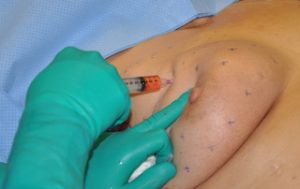Breast reconstruction uses two fundamental approaches, prosthetic implants and expanders and autologous (your own) tissues. In some cases, a mixture of the two is done. While the type of mastectomy and the size of the opposite breast play significant roles in the selection of the reconstruction choice, the one factor that plays the biggest role is whether the breast to be reconstructed has received or is going to receive radiation.
While radiation is lethal to tumor cells, it is also harmful to normal tissues as well. A breast that has received radiation may appear normal on the outside, but once it has been injured by surgery its altered state often becomes apparent. Wounds that would normally heal may be delayed and the infection risk is higher, particularly if any prosthetic device is implanted. At the least, an irradiated breast will develop significant capsular contracture around a prosthetic device later. Radiation produces a two-sided outcome, elimination of cancer cells and reduction of normal healing.
For this reason, breast reconstruction using prosthetic devices in patients who have undergone radiation is not recommended, unless there has been a muscle flap laid over the implant. That is why a recent article reporting on the use of injectable fat grafts around breast devices in irradiated wounds caught my eye. In the January 2010 issue of Plastic and Reconstructive Surgery, an article out of Spain reported on the use of fat grafting in postmastectomy breast reconstruction with expanders and prostheses in patients who have received radiotherapy. In a series of 65 prosthetic breast reconstruction patients, fat grafting was done by injection at the first stage of tissue expander placement and again at the second stage when the permanent implant replaced the expander. Their findings showed a remarkable lack of any infections, capsular contracture, and improved quality of the overlying breast skin.

I think this approach is very interesting and may have some real clinical value. But this article must be analyzed in the context of two important but understated elements of this article. First, all reconstructed patients were one year out from their mastectomies, known as secondary or delayed breast reconstructions. That is not the way most patients in the United States would like to have it done or actually do it. Primary reconstruction is the preferred approach which would preclude not only the technical approach of fat grafting but much of its benefits. Secondly, there was no sampling of the breast tissues so the belief that new tissue is formed and that the skin is better is a subjective and hopeful one, but not hard science.
For now, a far safer procedure that will have fewer healing complications is the use of autologous tissue in irradiated breast reconstructions. They are always a bigger operation and recovery and create a donor scar somewhere, but they have a more predictable outcome. Fat grafting may one day have an established role in breast reconstruction but it will likely be for subtotal breast defects in a delayed reconstruction role.
Dr. Barry Eppley
Indianapolis, Indiana


